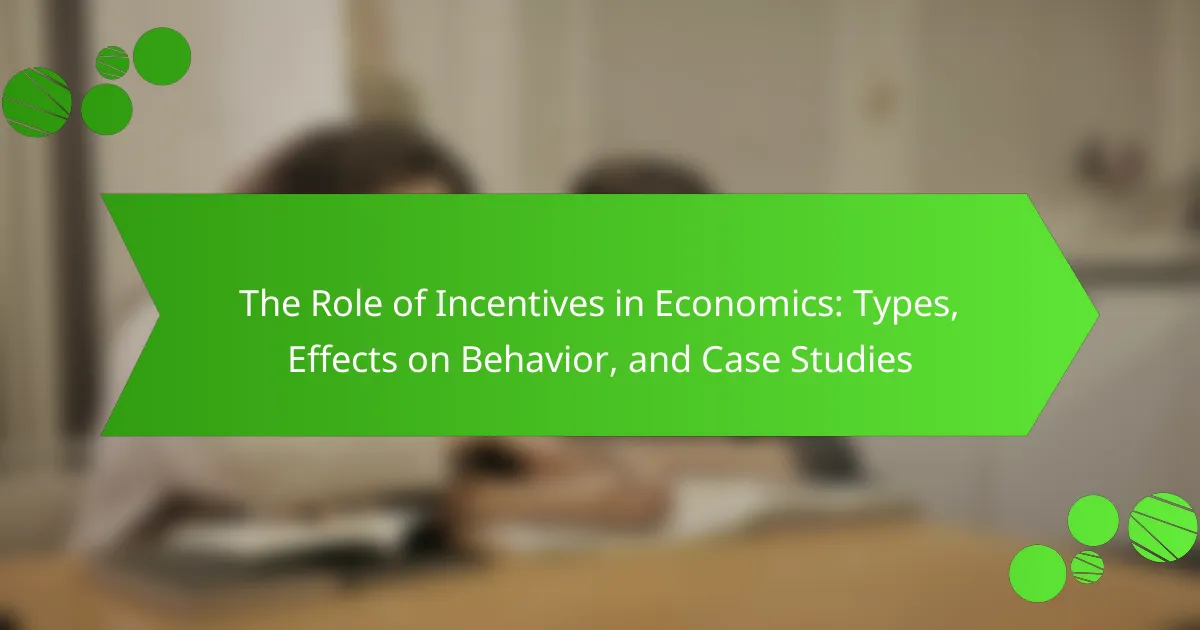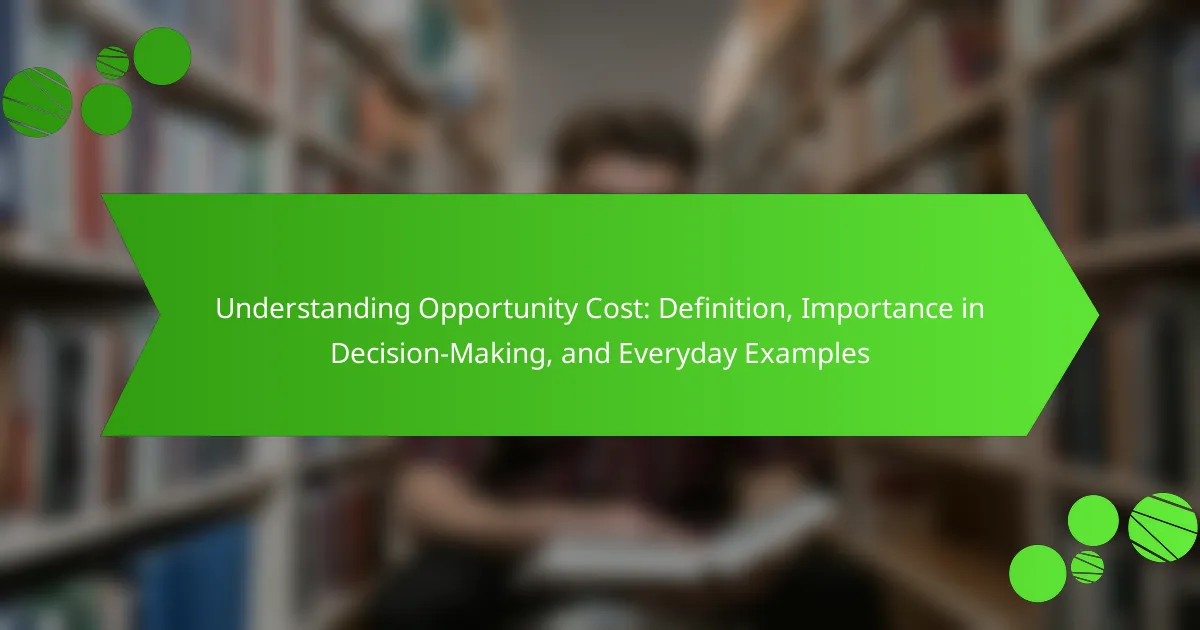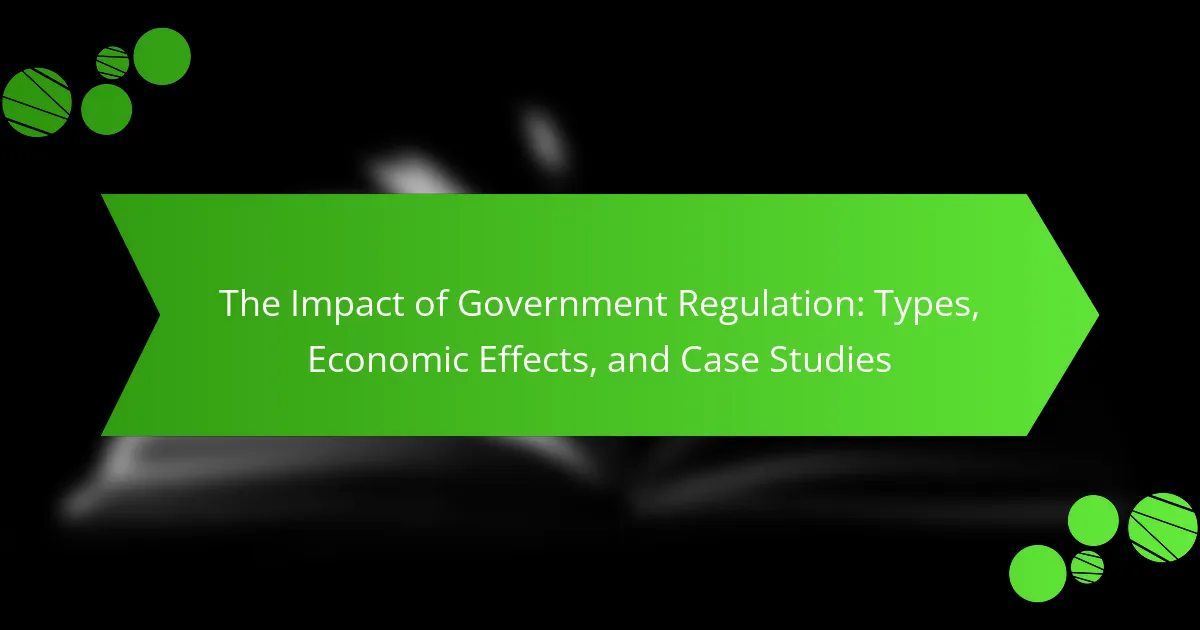Fiscal policy is the government’s strategic approach to managing the economy through taxation and spending. This article explores the key tools of fiscal policy, including government expenditure and tax adjustments, and their roles in promoting economic growth, stabilizing prices, and reducing unemployment. It examines historical examples, such as the New Deal and responses to the 2008 financial crisis, highlighting how fiscal policy can stimulate demand during recessions or cool down inflation during economic overheating. Additionally, the article evaluates the effectiveness of fiscal policy based on its impact on GDP growth and employment rates, emphasizing its significance in managing economic cycles and achieving fiscal objectives.
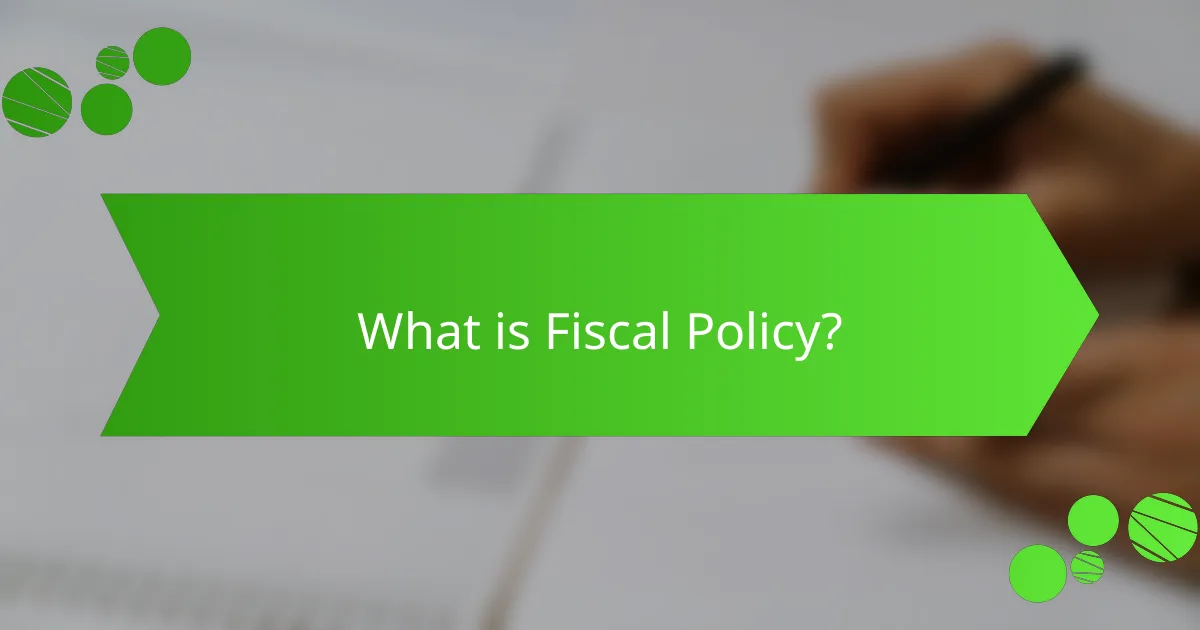
What is Fiscal Policy?
Fiscal policy refers to the government’s use of taxation and spending to influence the economy. It involves adjusting government revenue and expenditure levels to promote economic growth, stabilize prices, and reduce unemployment. For instance, during a recession, a government may increase spending or cut taxes to stimulate demand. Conversely, in times of economic overheating, it may reduce spending or raise taxes to cool down inflation. Historical examples include the U.S. government’s New Deal policies in the 1930s, which aimed to counteract the Great Depression through increased public spending. The effectiveness of fiscal policy is often evaluated through its impact on GDP growth and employment rates.
How does Fiscal Policy influence the economy?
Fiscal policy influences the economy by adjusting government spending and taxation. It affects aggregate demand, which in turn impacts economic growth. Increased government spending can stimulate economic activity during a recession. Conversely, higher taxes can reduce disposable income and slow down growth.
Fiscal policy also plays a role in managing inflation. For example, reducing spending can help control rising prices. The effectiveness of fiscal policy can vary based on the economic context. Historical examples include the New Deal, which helped the U.S. recover from the Great Depression.
In summary, fiscal policy is a critical tool for managing economic stability and growth.
What are the main components of Fiscal Policy?
The main components of fiscal policy are government spending and taxation. Government spending refers to the total expenditure by the government on goods and services. This spending can influence economic activity by creating jobs and increasing demand. Taxation involves the collection of revenue from individuals and businesses. It affects disposable income and consumption patterns. Together, these components help manage economic growth and stability. Historical data shows that changes in fiscal policy can significantly impact GDP growth rates. For example, during the 2008 financial crisis, increased government spending helped stimulate the economy.
How does government spending impact economic growth?
Government spending directly influences economic growth by increasing aggregate demand. When the government invests in infrastructure, education, or healthcare, it creates jobs and stimulates consumption. This spending can lead to a multiplier effect, where initial spending generates further economic activity. For example, a study by the International Monetary Fund (IMF) found that a 1% increase in government spending can raise GDP by approximately 0.6% to 1.5% in the short term. Additionally, government spending can enhance productivity by funding research and development. Overall, effective government expenditure is crucial for fostering sustainable economic growth.
What are the objectives of Fiscal Policy?
The objectives of fiscal policy are to influence economic activity, manage inflation, and promote employment. Fiscal policy aims to stabilize the economy through government spending and taxation. It seeks to achieve sustainable economic growth by adjusting public expenditures. Additionally, fiscal policy is designed to redistribute income to reduce inequality. Another objective is to maintain a balanced budget over the economic cycle. These objectives are essential for fostering a stable economic environment. Historical data shows that effective fiscal policies can lead to improved economic performance. For example, during the Great Depression, increased government spending helped stimulate recovery.
How does Fiscal Policy aim to achieve economic stability?
Fiscal policy aims to achieve economic stability through government spending and taxation. It influences overall economic activity by adjusting these components. Increased government spending can stimulate demand during economic downturns. Conversely, reducing spending or increasing taxes can help cool down an overheating economy.
This approach helps to manage inflation and unemployment levels. For example, during the 2008 financial crisis, many governments implemented stimulus packages to boost economic growth. Historical data shows that effective fiscal policy can lead to more stable economic conditions.
What role does Fiscal Policy play in addressing unemployment?
Fiscal policy plays a crucial role in addressing unemployment by influencing economic activity through government spending and taxation. Increased government spending can stimulate demand for goods and services, leading to job creation. For instance, during economic downturns, fiscal policy can include stimulus packages that fund infrastructure projects. These projects create jobs directly and indirectly by boosting related industries.
Tax cuts can also increase disposable income for consumers, encouraging spending and further stimulating demand. Historical data shows that during the 2008 financial crisis, fiscal measures such as the American Recovery and Reinvestment Act helped reduce unemployment rates by creating millions of jobs. Therefore, effective fiscal policy can significantly impact unemployment levels by enhancing overall economic growth.
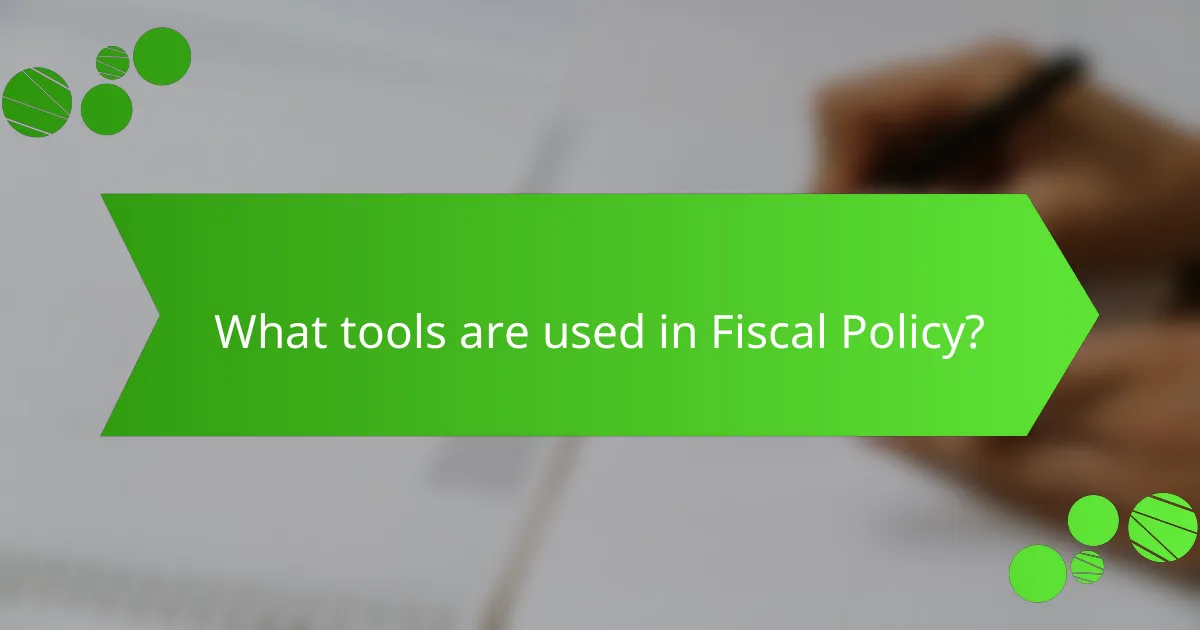
What tools are used in Fiscal Policy?
Fiscal policy utilizes several key tools to influence the economy. The primary tools are government spending and taxation. Government spending involves the allocation of funds for public services, infrastructure, and welfare programs. This spending can stimulate economic growth by increasing demand for goods and services. Taxation, on the other hand, adjusts the amount of money individuals and businesses pay to the government. Changes in tax rates can either encourage or discourage consumer spending and investment.
Historically, during economic downturns, governments may increase spending or cut taxes to boost economic activity. Conversely, in times of inflation, they may reduce spending or increase taxes to cool down the economy. These tools are essential for managing economic cycles and achieving fiscal objectives.
What are the primary tools of Fiscal Policy?
The primary tools of fiscal policy are government spending and taxation. Government spending involves the allocation of funds to various sectors such as education, infrastructure, and healthcare. This spending stimulates economic activity by creating jobs and increasing demand for goods and services. Taxation, on the other hand, involves the collection of revenue from individuals and businesses. Adjusting tax rates can influence consumer spending and investment. For example, lower taxes can increase disposable income, leading to higher consumer spending. Conversely, higher taxes can reduce spending and slow down economic growth. Together, these tools help governments manage economic stability and growth.
How do tax policies function as a tool of Fiscal Policy?
Tax policies function as a tool of Fiscal Policy by influencing government revenue and economic activity. They determine how much money the government collects from individuals and businesses. This revenue is essential for funding public services and investments. Tax policies can be adjusted to stimulate or slow down the economy. For instance, lowering taxes can increase disposable income, encouraging consumer spending. Conversely, raising taxes can help cool an overheated economy by reducing spending. Historical data shows that during economic downturns, tax cuts often lead to faster recovery. The Tax Cuts and Jobs Act of 2017 is an example of a tax policy aimed at stimulating growth. Overall, tax policies are a critical mechanism for governments to manage economic conditions.
What types of government spending are considered in Fiscal Policy?
Government spending in fiscal policy primarily includes two types: discretionary spending and mandatory spending. Discretionary spending involves expenditures that are determined through the annual appropriations process. Examples include funding for education, defense, and transportation. Mandatory spending, on the other hand, is required by law and includes programs such as Social Security, Medicare, and Medicaid. In the fiscal year 2022, mandatory spending accounted for approximately 62% of federal spending, highlighting its significant role in fiscal policy. These spending types are crucial for influencing economic activity and achieving policy objectives.
How does Fiscal Policy interact with monetary policy?
Fiscal policy interacts with monetary policy through their combined influence on economic stability and growth. Fiscal policy involves government spending and taxation decisions. These decisions can affect aggregate demand in the economy. When the government increases spending, it can stimulate economic activity. Conversely, tax cuts can increase disposable income for consumers.
Monetary policy, managed by a central bank, regulates the money supply and interest rates. Lower interest rates can encourage borrowing and investment. This complements fiscal policy efforts to boost growth. For instance, during a recession, expansionary fiscal policy can be supported by accommodative monetary policy.
Historically, during the 2008 financial crisis, coordinated efforts of fiscal stimulus and low interest rates were implemented to stabilize the economy. This illustrates how both policies can work together to achieve common economic goals.
What are the differences between Fiscal Policy and monetary policy?
Fiscal policy involves government spending and taxation decisions to influence the economy. It is managed by the legislative and executive branches of government. Monetary policy, on the other hand, refers to the management of the money supply and interest rates by a central bank. The central bank, such as the Federal Reserve in the U.S., implements monetary policy.
Fiscal policy aims to stimulate economic growth or control inflation through government budgets. It directly affects aggregate demand through changes in public spending and taxation. Monetary policy focuses on controlling inflation and stabilizing the currency. It influences economic activity indirectly by adjusting interest rates and regulating the money supply.
In summary, the primary difference is that fiscal policy is government-driven, while monetary policy is managed by central banks. Fiscal policy directly impacts the economy through spending and taxes. Monetary policy affects the economy through interest rates and money supply management.
How can Fiscal Policy complement monetary policy?
Fiscal policy can complement monetary policy by addressing economic challenges through government spending and taxation. When monetary policy is unable to stimulate demand, fiscal policy can step in to boost economic activity. For instance, during a recession, increased government spending can create jobs and increase consumer spending. Tax cuts can also leave individuals with more disposable income, further stimulating demand. Historical evidence shows that during the 2008 financial crisis, coordinated fiscal and monetary policies helped stabilize the economy. This collaboration can lead to a more effective overall economic strategy.
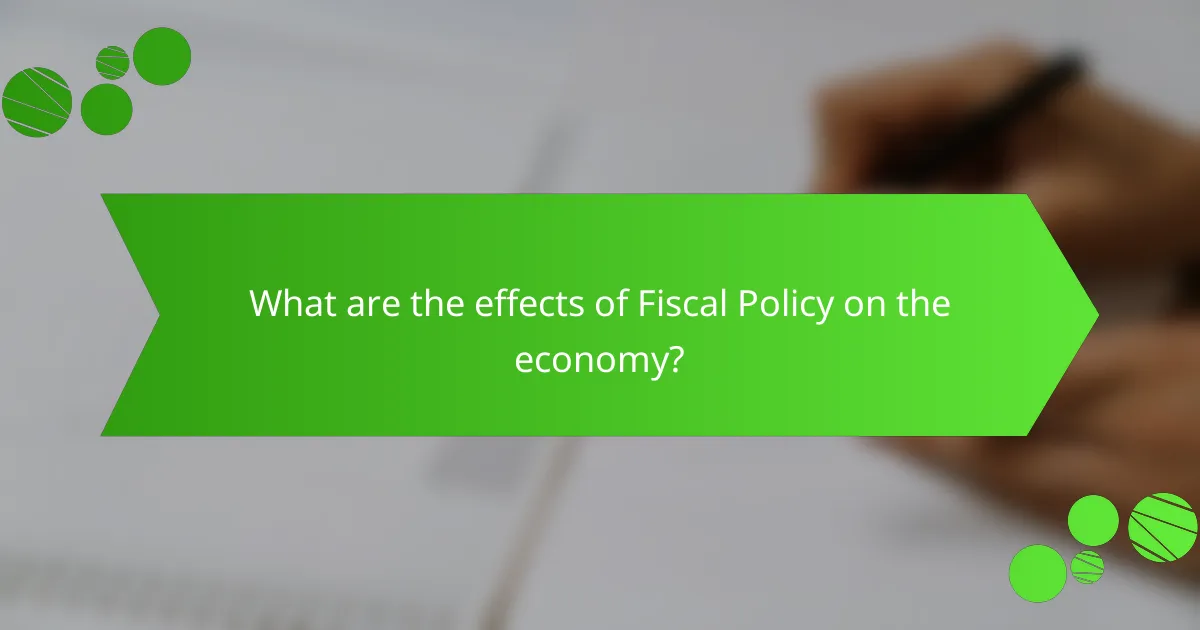
What are the effects of Fiscal Policy on the economy?
Fiscal policy influences the economy by altering government spending and taxation. Increased government spending can stimulate economic growth during a recession. For example, the 2008 financial crisis saw significant fiscal stimulus measures that helped revive economic activity. Conversely, higher taxes can reduce disposable income, potentially slowing economic growth. The Congressional Budget Office reported that fiscal policy can impact GDP growth rates significantly. Additionally, fiscal policy affects inflation rates through changes in aggregate demand. Effective fiscal policy can stabilize the economy and reduce unemployment. Historical evidence shows that countries employing counter-cyclical fiscal policies tend to recover more quickly from downturns.
How does Fiscal Policy affect inflation rates?
Fiscal policy directly influences inflation rates through government spending and taxation. When the government increases spending, it can boost demand for goods and services. Higher demand often leads to increased prices, contributing to inflation. Conversely, reducing spending or increasing taxes can decrease demand. This reduction can help lower inflation rates by stabilizing prices. Historical data shows that during the 2008 financial crisis, expansionary fiscal policy was used to stimulate the economy, resulting in short-term inflation increases. The relationship between fiscal policy and inflation is complex and varies based on economic conditions and consumer behavior.
What is the relationship between Fiscal Policy and consumer spending?
Fiscal policy directly influences consumer spending through government spending and taxation. When the government increases spending, it can boost demand for goods and services. This increased demand often leads to higher consumer spending as businesses respond to the demand. Conversely, higher taxes can reduce disposable income, leading to decreased consumer spending. Historical data shows that during economic downturns, expansionary fiscal policies, such as stimulus packages, often lead to increased consumer spending. For instance, the 2008 economic stimulus package resulted in a significant rise in consumer expenditure. Thus, the relationship between fiscal policy and consumer spending is significant and can impact overall economic growth.
How does Fiscal Policy impact investment levels in the economy?
Fiscal policy directly impacts investment levels in the economy through government spending and taxation. Increased government spending can stimulate demand for goods and services. This demand encourages businesses to invest in new projects and expand operations. Conversely, higher taxes can reduce disposable income for consumers and businesses. This reduction can lead to lower investment levels as companies may have less capital to reinvest. Historical data shows that during economic downturns, expansionary fiscal policies, such as the 2008 stimulus package, led to increased investment levels. In contrast, austerity measures often correlate with decreased investment. Therefore, the nature of fiscal policy significantly influences overall investment dynamics in the economy.
What are the potential drawbacks of Fiscal Policy?
Potential drawbacks of fiscal policy include increased public debt, inflation, and time lags in implementation. Increased public debt occurs when governments borrow to fund spending. This can lead to higher interest rates over time. Inflation may arise if government spending stimulates demand excessively. Time lags are significant because fiscal measures take time to design, implement, and affect the economy. For instance, the Congressional Budget Office reported that it can take several months for a stimulus package to impact GDP. Additionally, fiscal policy can lead to inefficient allocation of resources. This inefficiency can arise from political motivations rather than economic needs.
How can excessive government spending lead to deficits?
Excessive government spending can lead to deficits when expenditures exceed revenues. When a government spends more than it collects in taxes, it must borrow to cover the difference. This borrowing increases national debt, which can lead to higher interest payments in the future. For example, in 2020, the U.S. federal deficit reached $3.1 trillion due to increased spending in response to the COVID-19 pandemic. Continued high levels of spending without corresponding revenue increases can create a cycle of deficits. This situation may result in reduced investor confidence and higher borrowing costs over time.
What are the risks of using Fiscal Policy to stimulate the economy?
Using fiscal policy to stimulate the economy carries several risks. One significant risk is inflation. Increased government spending can lead to higher demand for goods and services, driving prices up. Another risk is the potential for increased public debt. If government borrowing rises significantly, it may lead to unsustainable debt levels. Additionally, fiscal policy can create inefficiencies in resource allocation. Misguided spending may not target areas that yield the highest economic returns. There is also a risk of crowding out private investment. When the government borrows heavily, it can lead to higher interest rates, discouraging private sector investment. Lastly, fiscal policies may have time lags. The effects of implemented policies may take time to materialize, leading to delayed economic responses. These risks highlight the complexities involved in using fiscal policy effectively.
What practical considerations should policymakers keep in mind regarding Fiscal Policy?
Policymakers should consider the economic context when implementing fiscal policy. Economic growth rates influence the effectiveness of fiscal measures. High unemployment may require expansionary fiscal policies to stimulate demand. Conversely, in times of inflation, contractionary policies may be necessary to cool the economy.
Debt levels are also critical. High public debt can limit future fiscal flexibility. Policymakers must balance short-term stimulus with long-term sustainability. The distributional impact of fiscal policies should be assessed. Equity considerations can affect social stability and public support.
Finally, timing is crucial. Policymakers should implement measures when they can have the most impact. Delayed actions can lead to missed opportunities for economic recovery or stabilization.
Fiscal policy is the government’s strategic use of taxation and spending to influence economic conditions. This article explores the key components of fiscal policy, including government spending and taxation, and their roles in promoting economic growth, managing inflation, and addressing unemployment. It also examines the tools of fiscal policy, such as discretionary and mandatory spending, and the interaction between fiscal and monetary policies. Additionally, the article discusses the potential drawbacks and practical considerations policymakers must keep in mind when implementing fiscal measures. Overall, it highlights the significant impact of fiscal policy on economic stability and growth.
